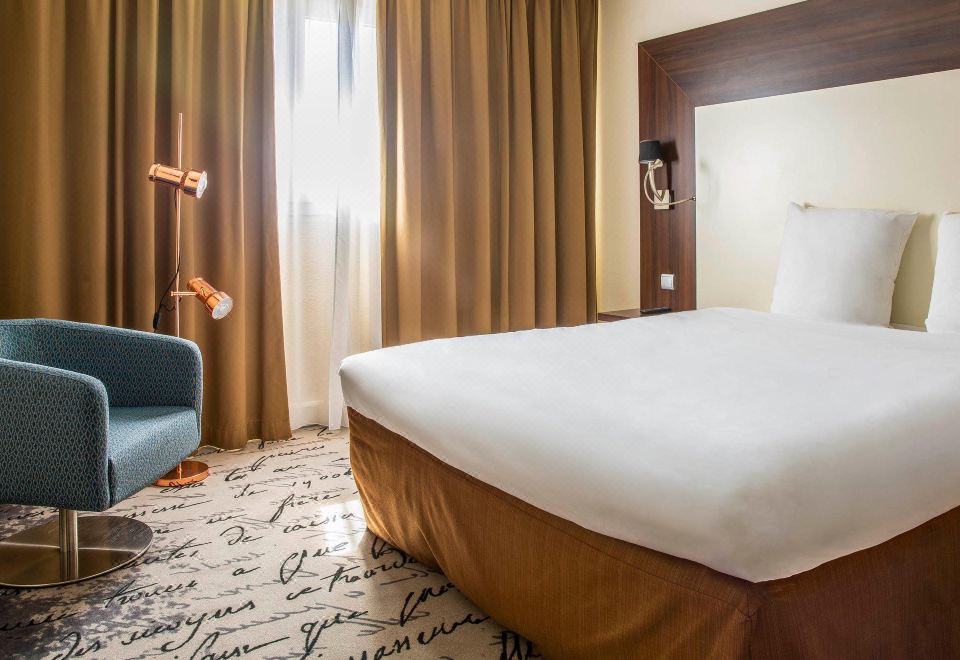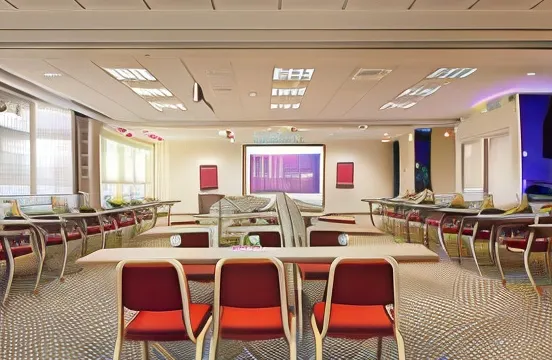Hôtel Mercure Paris Porte d'Orléans
1 night
Rooms and Guests
1 room, 2 adults, 0 children
All Properties in Montrouge
Hôtel Mercure Paris Porte d'Orléans
13 Rue François Ory, Montrouge, Ile-de-France, 92120, France
Show on Map
We Price Match







Amenities
Public parking
EV charging station
24-hour front desk
Luggage storage
Bar
Cafe
Taxi booking service
Conference room
All Amenities
Property Description
Discover Mercure Paris Porte d'Orléans: a family haven with spacious suites featuring retro-vintage decor inspired by the Draeger brothers' printing. Enjoy 150m² adaptable meeting spaces, secure undercover car park, and our restaurant with seasonal French cuisine. Experience unforgettable comfort, elegance, and convenience in Paris, blending warmth with modern amenities.
Show More
7.6/10
GoodVery good service.
All 47 Reviews
Surroundings
Metro: Mairie de Montrouge
(750m)
Metro: Porte d'Orléans
(840m)
View on Map
Overview
Rooms
Guest Reviews
Services & Amenities
Policies

6
Classic Twin Room
2 Single bed
Has window
Non-smoking
Air conditioning
Private bathroom
Refrigerator
Minibar
Check Availability

9
Classic Room With Double Bed
1 Double bed
Has window
Non-smoking
Air conditioning
Private bathroom
Refrigerator
Minibar
Check Availability

6
Privilege Room With Double Bed
1 Double bed
Has window
Non-smoking
Air conditioning
Private bathroom
Refrigerator
Minibar
Check Availability

9
Family Room-1 Double Bed And 1 Sofa Bed For 1 Person
1 Double bed and 1 Sofa bed
Has window
Non-smoking
Air conditioning
Refrigerator
Minibar
TV
Check Availability

7
Privilege Twin Room
2 Single bed
Has window
Non-smoking
Air conditioning
Private bathroom
Refrigerator
Minibar
Check Availability
Hide Room Types
Guest Reviews
7.6/10
Good
47 reviews
 Verified Reviews
Verified Reviews- Cleanliness7.5
- Amenities7.4
- Location7.7
- Service7.7
Average for similar properties in Montrouge

Anonymous User
June 1, 2025
The Louvre Museum is an awe-inspiring testament to human creativity, history, and culture, offering a truly unforgettable experience for art lovers and casual visitors alike. Nestled in the heart of Paris, the museum itself is a masterpiece, with its iconic glass pyramid entrance juxtaposed against the grandeur of the former royal palace. From the moment you step inside, you’re swept into a vast labyrinth of galleries that span centuries and continents, housing over 35,000 works of art. The most famous, of course, is Leonardo da Vinci’s Mona Lisa, and while the crowd around it can be intense, seeing her enigmatic smile in person is a rite of passage for any art enthusiast. But the Louvre is far more than just that single painting. The richness of its collection is staggering—whether you're gazing at the monumental Winged Victory of Samothrace, standing before the Venus de Milo, or marveling at the dramatic canvases of French Romanticism, the museum constantly surprises and captivates. Each wing of the Louvre unfolds like a different world: the ancient Egyptian artifacts transport you to a civilization thousands of years old, while the Islamic art wing showcases breathtaking tilework, calligraphy, and design. What truly makes the experience exceptional is how seamlessly the museum blends its immense scale with intimate moments—quiet corners where you can pause before a lesser-known masterpiece and feel as though you’ve discovered a hidden gem. The layout can be overwhelming, so first-time visitors might benefit from choosing a thematic route or guided tour, lest they get lost in the endless corridors. Despite its size, the Louvre maintains an incredible sense of curation; the lighting, spacing, and presentation of each artwork feel purposeful and respectful. Facilities are well-maintained, with cafes and rest areas offering welcome breaks during a long visit. Staff are helpful and security is professional yet unobtrusive, ensuring that the artwork is protected without hindering the visitor experience. Visiting during early mornings or late evenings often makes for a more peaceful experience, especially if you're hoping to linger in front of popular pieces. Ultimately, a trip to the Louvre is more than just a museum visit—it’s a cultural pilgrimage. It invites you to reflect not only on artistic genius but also on the evolution of human civilization itself. Whether you spend two hours or an entire day there, the Louvre leaves a deep impression that lingers long after you exit its doors.

Anonymous User
May 31, 2025
Clean functional hotel, but a bit difficult to get to from metro station.

Guest User
May 21, 2025
The room is good, a bit far from the subway station
Original TextTranslation provided by Google

LOTKA
February 17, 2025
The room is big and clean
Original TextTranslation provided by Google

CarolinaDelgado
January 12, 2025
Very good service.
Original TextTranslation provided by Google

Guest User
December 31, 2024
Very close to Paris, convenient transportation, average front desk service
Original TextTranslation provided by Google

Guest User
November 21, 2024
Safe location, good service.
Original TextTranslation provided by Google

Andrei
November 16, 2024
Honestly, you don't deserve four stars, the Wi-Fi doesn't even work in the room, you have to go down to the lobby
Original TextTranslation provided by Google

Guest User
July 22, 2024
Excellent clean hotel, quiet part of Paris 15minutes Uber or bolt to centre of Paris. Staff fluent in English. We arrived a few hours earlier and they let us come in earlier without hesitation. Would stay there again
Services & Amenities
Most Popular Amenities
Public parking
Additional charge
EV charging station
24-hour front desk
Luggage storage
Bar
Cafe
Taxi booking service
Conference room
Additional charge
Business center
Multi-function room
Wake-up call
Wi-Fi in public areas
Free

Bar

Conference room

Multi-function room
Restaurant
L'Atelier des Saisons
Style: A la carte
Cuisine: French, International
Open for: Lunch, Dinner
Special dietary options: Vegetarian
Ambience: Modern
Dining options: Reservations available
Business hours: [Mon - Thurs] 12:00-14:00, 19:00-22:00,[Fri] 12:00-14:00
Notice: The amenity will be closed during your selected stay dates. Please contact the hotel in advance for details.
More Amenities
Internet
Wi-Fi in public areas
Free
Parking
Public (not only for guests) is available On-site parking, and Charge, €22.50 (approx. PHP 1,423.21) Daily. Reservation not needed.
Public parking
Additional charge
Car charging facilities
Transportation
Taxi booking service
Front Desk Services
Luggage storage
Wake-up call
24-hour front desk
Express check-in and check-out
Languages Spoken
English
Arabic
French
German
Italian
Portuguese
Spanish
Food & Drink
Cafe
Bar
Room service
Lobby bar
Snack bar
Convenience store/kiosk
Alcohol-free rooms (on request)
Public Areas
Elevator
No smoking in public areas
Cleaning Services
Laundry service (on-site)
Additional charge
Clothes dryer
Facilities for Children
Children's meals available
Business Services
Conference room
Additional charge
Business center
Postal service
Fax/copying service
Multi-function room
Accessibility
Accessible rooms available
Safety & Security
First aid room
CCTV in public areas
First aid kit
Fire alarm
Fire extinguisher
Smoke detector
Intruder alarm
Property Policies
Check-in and Check-out Times
Check-in: After 14:00
Check-out: Before 12:00
Front desk hours: 24/7
Child Policies
Children of all ages are welcome at this property.
Additional fees may be charged for children using existing beds. Add the number of children to get a more accurate price.
Cribs and Extra Beds
For all room types, cribs cannot be added. Extra bed policies vary according to room type. Please refer to the relevant room type policy.
Breakfast
TypeContinental, Gluten-free, Vegan, Vegetarian
StyleBuffet
| Age | Fee |
|---|---|
Adult | Buffet:€19.90 (approx. PHP 1,258.75) per person |
Additional breakfast fees are not included in the total and need to be paid at the property.
Deposit Policy
DepositDeposit required
Deposit Collection MethodsA fixed amount of €100.00 (approx. PHP 6,325.34) is charged.
Deposit Payment MethodsThis property accepts credit cards
Deposit RefundThe deposit will be returned to the original account of payment within 7 days after check-out.
Pets
Pets are allowedAdditional charge
Fee: €10.00 (approx. PHP 632.54) per pet per day
Service Animals
Service animals are allowed
Age Requirements
The main guest checking in must be at least 18 years old
Paying at the Hotel




- Cash
Property Description
- Opened: 1977
- Renovated: 2005
- Number of Rooms: 188
Discover Mercure Paris Porte d'Orléans: a family haven with spacious suites featuring retro-vintage decor inspired by the Draeger brothers' printing. Enjoy 150m² adaptable meeting spaces, secure undercover car park, and our restaurant with seasonal French cuisine. Experience unforgettable comfort, elegance, and convenience in Paris, blending warmth with modern amenities.